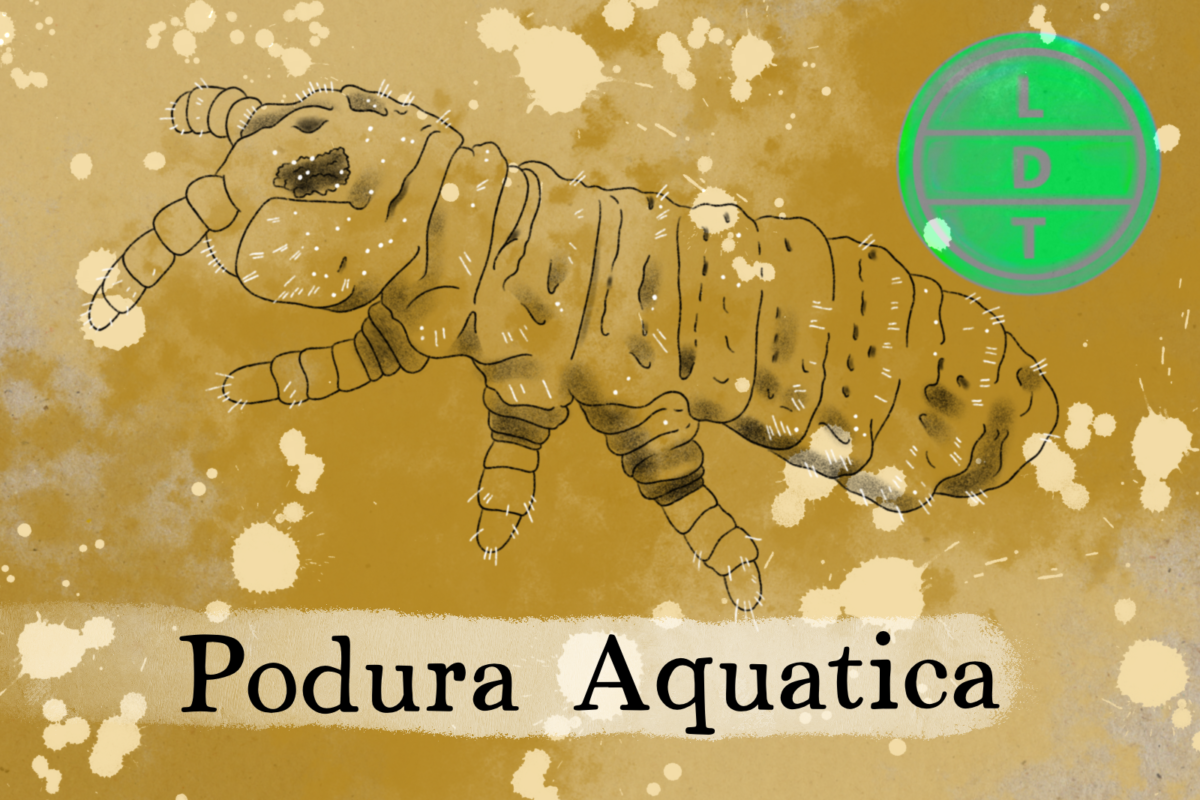“…and today we’re talking about an aquatic acrobat. But more on that later.”
When you’re tiny the God hands you a different set of rules than the laws of physics humans are used to. When you hear the name water springtail, you might think of a fish or maybe a deer, but it’s actually a tiny arthropod that lives on the surfaces of ponds. In this placid world, it takes some special skills to get around. But with tiny physics, you can do anything you set your little mind to, in Life, Death, and Taxonomy.
Description of the Water Springtail
- Looks like a little soggy blue-gray earwig
- Oblong, segmented body
- Six orangish legs
- Two orangish antennae
- Looks like an ant that’s one of those “grows 20x in water”
Measure Up
Welcome to the beloved Measure Up segment. The official listener’s favorite part of the show! The part of the show when we present the animal’s size and dimension in relatable terms through a quiz that’s fun for the whole family. It’s also the part of the show that’s introduced by you when you send in audio of yourself saying, singing, or chittering the words Measure Up into ldtaxonomy at gmail dot com. We don’t have a new Measure Up intro!
Length
- 1.5 mm (0.059 inches)
- How many springtails can the USS Iowa-class battleships travel in an hour?
- Hint: The USS Iowa-class battleships were used during WWII and were powered by eight fuel oil boilers and four propellers.
- 65,178,432 springtails. Iowa class ships traveled at a speed of 40.5 miles per hour or 35.2 knots.
Leap Distance
- 6.6 cm
- How many springtail jumps go into a tiger jump?
- Hint: A tiger possesses the ability to jump a little more than its body length straight up in the air. Some reports say they can almost double their body length with a jump.
- 55.4 jumps. Tigers can generally jump about 12 feet up.
Fast Facts about the Water Springtail
- Range: Lives in still, fresh water all around the Holarctic realm – which is a fancy way of saying the Northern Hemisphere
- Diet: decaying organic materials, especially decomposing plants, as well as fungal foods such as molds and mildews.
- Behavior:
- They deposit eggs on the water surface. The eggs are hydrophilic and immediately sink to the bottom. The embryo develops under water. The hatchling has a hydrophobic cuticle and rises up to the surface to continue its post-embryological development on the water surface.
Major Fact: Springs on Springs
The water springtail has a specialized leaping organ called the furcula. The furcula is a little lever at the bottom of their abdomen that is normally folded forward under the abdomen. When the springtail needs to jump, it snaps the furcula open. If you’ve ever had a wind up flipping toy, it is very similar.
The powerful snap of the furcula allows a powerful jump. On solid flat surfaces, the water springtail can achieve a maximum jump height that is 44 times its body length.
Water springtails also float on the surface of the water. They can even jump on the water surface, defying gravity due to their unique leaping mechanism. Remarkably, water springtails can also jump from inside air bubbles.
Their ability to transition from water to air demonstrates their agility. Microscopic observations reveal that the leaping organ has a hollow cavity with cracks. The concavo-convex shape of the ventral groove in the abdominal segment of the springtail fits perfectly with the leaping organ.
Ending: So get together with your buds, munch on some decaying organic material, and jump off the surface of the water like you have 20 points in acrobatics in an Elder Scrolls game here in LDT.

